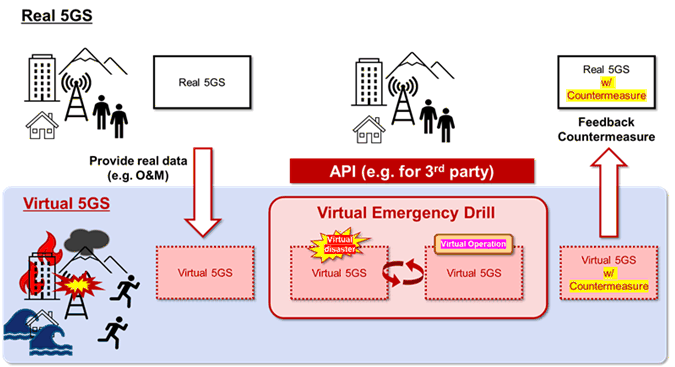Content for TR 22.856 Word version: 19.2.0
1…
5…
5.2…
5.3…
5.4…
5.5…
5.6…
5.7…
5.8…
5.9…
5.10…
5.11…
5.12…
5.13…
5.14…
5.15…
5.16…
5.17…
5.18…
5.19…
5.20…
5.21…
5.22…
5.23…
5.24…
5.25…
5.26…
5.27…
5.28…
6
7…
7.2
8
A
B
C…
5.21 Use Case on Virtual Emergency Drill over 5G Metaverse
5.21.1 Description
5.21.2 Pre-conditions
5.21.3 Service Flows
5.21.4 Post-conditions
5.21.5 Existing features partly or fully covering the use case functionality
5.21.6 Potential New Requirements needed to support the use case
...
...
5.21 Use Case on Virtual Emergency Drill over 5G Metaverse p. 67
5.21.1 Description p. 67
An Emergency Drill is a crucial activity for governments, local municipalities, and citizens to prepare for potential disasters such as earthquakes, fires, and floods. To make the drills more effective, it is important for a wide range of people, organizations, and government entities to participate and create simulations that are as close to real-life disaster scenarios as possible. The use of a metaverse environment is expected to significantly enhance the value of these drills. With the ability to provide a more realistic experience, the Emergency Drill in the metaverse is expected to not only improve response to direct damage from emergencies, but also provide valuable data on human thoughts, decisions, and actions in actual crisis situations.
It is also important for mobile operators to anticipate traffic patterns related to confirming people's safety or evacuation actions during an emergency, and take measures to address potential data traffic congestion, overload, or failure of base stations or network equipment. The mobile network operator should be prepared not only for disasters but also large-scale network failures. They has to be able to quickly and accurately assess the extent of damage and impact and take timely action to recover their networks.
5.21.2 Pre-conditions p. 68
City A, known for its beautiful beaches, attracts many visitors each year. However, it is located near the sea and is at risk of suffering significant tsunami damage in the event of a major earthquake. With the challenges of providing rapid evacuation guidance for residents, saving lives, and restoring infrastructure, City A holds an annual comprehensive emergency drill. Although the drill is typically held on a holiday, the number of participants has been decreasing in recent years due to work, leisure, or COVID-19. This year, City A has decided to conduct the emergency drill in the metaverse environment to address this issue.
5.21.3 Service Flows p. 68

- City A is planning a virtual emergency drill that participants can access from any location, such as their office, home, or even the beach.
- Mobile operator B will provide the 5G system and anticipated operational and maintenance data for the emergency drill in the metaverse environment.
- In the metaverse environment, a virtual disaster, such as an explosion of Mt. Fuji, is simulated, and participants, including citizens, organizations, and governments, will immediately respond by assessing the damage, conducting evacuation and rescue activities, and taking other necessary actions in the virtual space.
- City A and designated organizations will collect various types of data during the emergency drill.
- Additionally, Mobile operator A will collect data in the virtual network environment, taking into account actual operational and maintenance data from the real environment, such as UE mobility, overload, and out of coverage, to evaluate the impact of the network in the event of a disaster and implement necessary countermeasures in the virtual environment.
5.21.4 Post-conditions p. 69
By participating in emergency drills, citizens and organizations learn how to respond to disaster scenarios, such as evacuations and rescues, and this information can be incorporated into local government disaster preparedness plans. Additionally, mobile operators can take effective measures to counteract potential network failures and other adverse impacts.
5.21.5 Existing features partly or fully covering the use case functionality p. 69
No existing features are identified.
5.21.6 Potential New Requirements needed to support the use case p. 69
No potential new requirements have been identified.